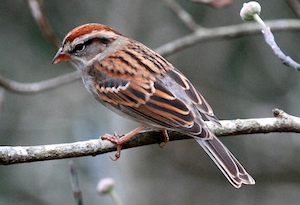
By Terry W. Johnson
One of the birds that is likely to visit my feeders on any day throughout the year is the chipping sparrow. If you live north of the Fall Line (the bird's main breeding range in the state), this may be the case in your backyard too. If you live in south Georgia, more than likely you see chipping sparrows primarily in the fall and winter.
Although practically everyone in the state sees the chipping sparrow, most do not know its name. Many simply call it a sparrow. This is unfortunate because this unassuming bird is both a fascinating and valuable backyard neighbor.
While it is true that most sparrows do indeed look very much alike, it is easy to separate this 5-inch bird from its relatives. Adult chipping sparrows have grayish white breasts, a black line through their eye, a white eyebrow line and a rufous cap. The cap takes on an added luster during the breeding season. Immature chipping sparrows look like adults except they have a light crown stripe instead of a rufous cap.
The bird's call has been described as soft mechanical trill that sounds something like a rapidly repeated chippy, chippy, chippy.
During the breeding season, which begins in early April and peaks in May and June, the chipping sparrow sings incessantly. Beginning well before daylight and continuing throughout the day, a bird might sing 330 times per hour. If fact, it has been estimated that a chipping sparrow might sing at least 200,000 times and easily twice that during the breeding season.
The chipping sparrow is a bird that has undoubtedly benefited from the changes we have made to the Georgia landscape. Originally, a bird of open pine woodlands, it now can be found in a variety of other places such as along highways, in parks and in suburban areas.
There was a time when folks called it the social bird because it was often found living near people. It has also been called the hair bird because its nests were often woven through with long horse hair—and some made entirely of horse hair have been found. Nowadays, since horses since have given way to cars as our primary means of transportation, chipping sparrow nests are more apt to be constructed of grasses. However, lacking a source of horse hair, the birds will sometimes incorporate cow and deer hair.
The chipping sparrow has long been recognized as a natural insect control agent. Although the species is considered primarily a seed eater, it does eat insect pests. This is particularly true during the nesting season when insects comprise 93 percent if its diet. Three-fourths of these insect are considered pests. One early naturalist watched a chipping sparrow gobble down 54 cankerworms in one sitting.
This tiny bird is particularly fond of caterpillars that bristle with spines. They also eat grasshoppers, beetles and other six-legged critters.
Remarkably, in spite of the fact the chipping sparrow is abundant today, populations of this bird declined abruptly when the house sparrow population exploded during the latter part of the 19th century. Fortunately, in those areas where house sparrow populations have since gone down, chipping sparrows have made a dramatic comeback.
If you would like to attract more chipping sparrows to your yard, all you have to do is feed them. They do not eat sunflower seeds; however, they are particularly fond of red and white millet. Other foods they will eat include scratch feed, cookie crumbs, doughnuts, cornbread, peanut hearts and crushed pecans. They will also dine on mealworms. I personally feed them white millet. Since the birds are ground feeders, you can scatter the seed directly on the ground. However, they will visit feeders with feeding trays or hopper feeders.
Autumn is a great time of the year to become acquainted with the chipping sparrow. For those of you who live in the northern half of the state, the numbers of these birds—smaller during spring and summer—begin to swell in the fall. For those folks living south of the Fall Line, chipping sparrows will begin showing up at feeders for the first time since winter. The upswing in the numbers of chipping sparrows seen throughout the state is due, in part, to the arrival of northern migrants.
By winter, local chipping sparrows and their northern cousins form flocks of 200 or more individuals. As such, it is not uncommon to have 30 to 100 or more feeding in your yard at this time of year.
And if you begin feeding chipping sparrows now, chances are some will return to your feeders next year. In the meantime, once you get to know the chipping sparrow, you will wonder why you did not make the acquaintance of this tiny brown bird a long time ago.
Terry W. Johnson is a former Nongame program manager with the Wildlife Resources Division and executive director of The Environmental Resources Network, or TERN, friends group of the division’s Nongame Conservation Section. (Permission is required to reprint this column.) Learn more about TERN, see previous “Out My Backdoor” columns, read Terry’s Backyard Wildlife Connection blog and check out his latest book, “A Journey of Discovery: Monroe County Outdoors.”





